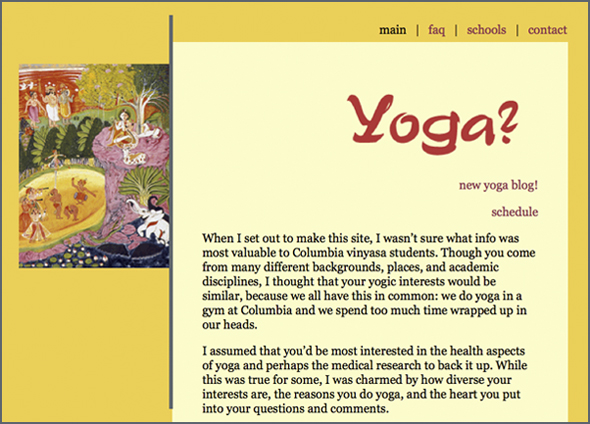yoga practice in class and out

This post is part of an integration of the info on the first yoga site I made for students back in 2007, as I’ll be taking it down soon. Enjoy!
Q: Is there a minimum amount of time that you should practice? Is it worth practicing 10 minutes if that’s all the time you have? –M.M.
M.M.— This is a difficult question. The standby, “it depends on you, your needs, goals, and schedule” is true, but also frustrating, especially if you are new to yoga and just want some steadfast answers.
Ten minutes is enough to make a difference, believe it or not. If I have to squeeze in a bare minimum, I do a:
2-minute Uttanasana (standing forward bend)
2-minute Adho Mukha Svanasana (downward dog)
2-minute Sirsasana (headstand, or substitute L-pose, dolphin, handstand or your favorite)
2-minute Sarvangasana (shoulderstand)
2-minute Savasana (relaxation pose)
Though it’s tempting, don’t skip the Savasana. It is the most important pose.
If you have only 5 minutes, or even 2, take the time to do a forward bend or down dog, and gently bring yourself back to the breath each time you stray. These few moments can shift your awareness, and it may open up time for more. This is especially true when you feel like you don’t have time!
Q: Would it be better to practice twice a week for an hour instead of doing once a week for an hour and a half? –M.M.
Yes. An hour-and-a-half class is great, but if you don’t practice more at home, one hour, twice a week is better.
Q: How do I find the discipline and inspiration to make my home practice an every day occurrence? –B.J.
One teacher told me that if you want to change your habitual patterns, and therein your life, simply dedicate 5 minutes a day to something you love and believe in. This can be yoga, meditation, drawing, singing—whatever it is that lights you up. Give yourself to it fully for those 5 minutes and do it everyday (not 5m. today, 0m. tomorrow, and 15m. the next), no matter what comes up. We humans are so fond of our fixed ways that we will create resistance to even this small act of awareness. Somehow, we can watch that and move past it, and those 5 minutes develop into something much larger.
Q: I’ve begun to wonder a little bit (and this is strictly based upon my own idiosyncrasies) what a yoga class would be like conducted in silence. Is it possible to do? Is it done? I think that listening is a very good practice but I worry about how much privilege we give to the voice. What does yogic philosophy say about this? –R.W.J.C.
Mysore-style Ashtanga is more or less conducted in silence, but for the Ujjayi breathing that fills the room. The teacher does walk around and make individual corrections (using voice and touch), but it’s directed to one person rather than the entire room.
Yogic philosophy has much to say about sound as well as voice, which can be used for creating sacred sound, or a scattered, unfocused state of mind, and everything in between. Read the Upanisads if you are interested. The Olivelle translation is direct and free from extensive figurative translation.
C: Yes, I have a personal practice. I sort of weave yoga into my day every day…I can’t seem to help it. –R.W.J.C.
Excellent, R. That made me grin. Let’s hope we all get there—I must admit there are days I’d rather just stay in bed and read.
to close, a short video of John Cleese on the benefits of laughing yoga.